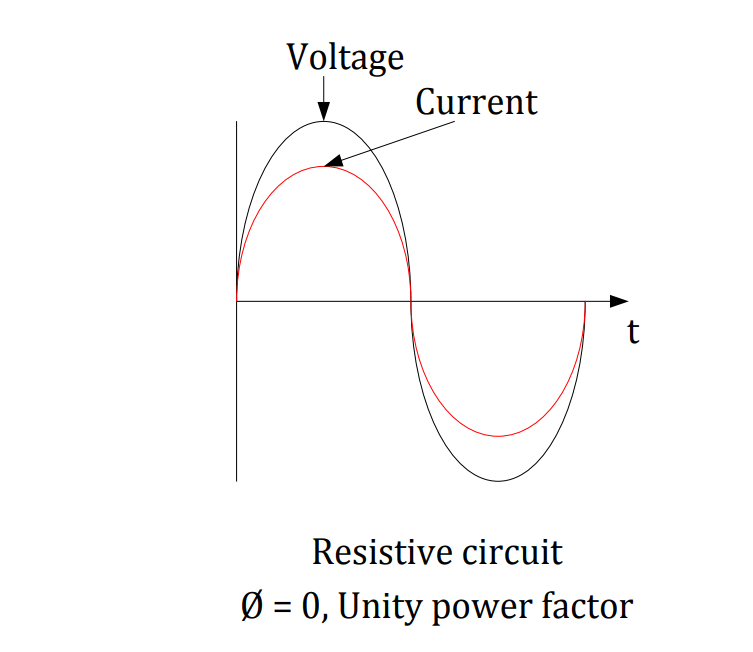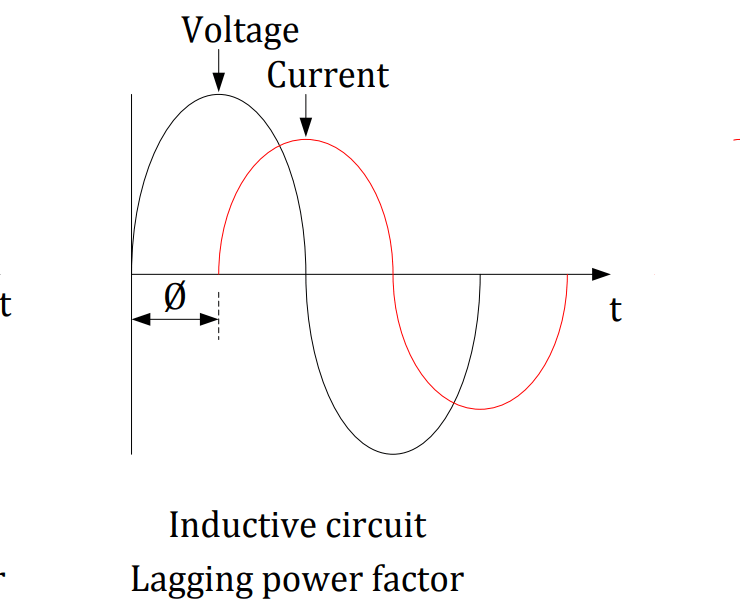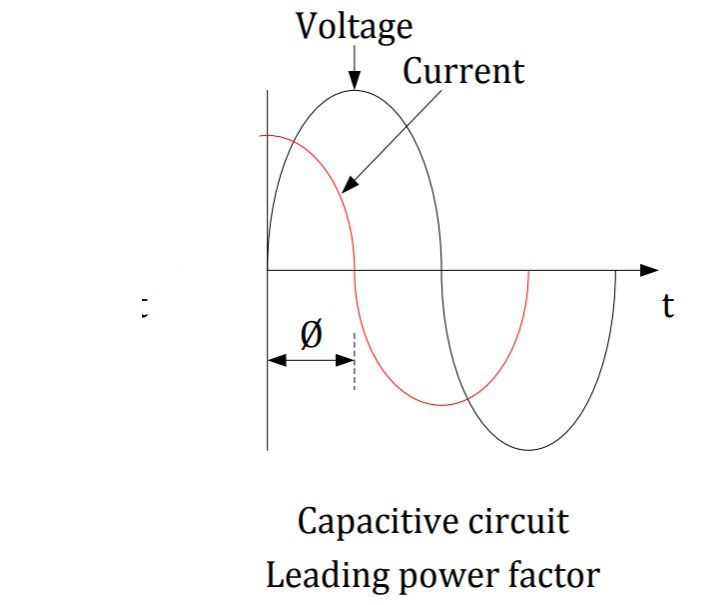Table of Contents
ToggleDefinition
The Power Factor (P.F.) is a ratio of the real power that is used to do work and the apparent power that is supplied to the circuit.
𝑃. 𝐹. = 𝑘𝑊/𝑘𝑉A
The P.F. is widely known as the cosine angle between fundamental voltage and current.The P.F. is a dimensionless number in the closed interval of 0 to 1.
Power factor is the factor upto which the power is actively used out of the total power generated. Meaning, the power generated is apparent power, out of which, the active usable power is apparent power times the power factor.
Introduction
Power factors are usually stated as “leading” or “lagging” to show the sign of the phase angle.
The P.F. of 1 means that the voltage and current waveform are in phase.When the power factor is 1, all the energy supplied by the source is consumed by the load.
The P.F. of less than or greater than 1 means that the voltage and current waveform are not in phase.
Capacitive loads are leading (current leads voltage), and inductive loads are lagging (current lags voltage).Due to energy stored in the load and returned to the source, or due to a non-linear load that distorts the wave shape of the current drawn from the source.
Power factor Calculation formula

We have calculate Power factor using In this Fig. data.
kW=912, kVA=1260
Power Factor= kW/kVA=912/1260=0.72
Types of Power Factor
power factor can be classified as following:
1) As per the supply consideration;
Displacement power factor
True power factor
2) As per the nature of load consideration;
Unity power factor
Lagging power factor
Leading power factor
Displacement power factor
Displacement power factor is the cosine of the angle between fundamental voltage and current waveforms. The fundamental waveforms are by definition pure sinusoids. But if the waveform distortion is due to harmonics, the power factor angles are different than what would be for the fundamental wave alone.
The presence of harmonics also affects overall power factor of the system.
True power factor or Distortion power factor
True power factor is calculated as the ratio between the total active power used in a circuit (including harmonics) and the total apparent power (including harmonics) supplied from the source.
T𝐫𝐮𝐞𝐩𝐨𝐰𝐞𝐫𝐟𝐚𝐜𝐭𝐨𝐫 = 𝐓𝐨𝐭𝐚𝐥𝐚𝐜𝐭𝐢𝐯𝐞𝐩𝐨𝐰𝐞𝐫/𝐓𝐨𝐭𝐚𝐥𝐚𝐩𝐩𝐚𝐫𝐞𝐧𝐭𝐩𝐨𝐰𝐞𝐫
Utility penalties are based on the true power factor of a facility.
Unity power factor (for resistive load)

If a purely resistive load is connected to a power supply, current and voltage will change polarity in step, the power factor will be unity (1), and the electrical energy flows in a single direction across the network in each cycle.
When the power factor is 1, all the energy supplied by the source is consumed by the load. Unity power factor occurs in resistive type load. For pure resistive load, power factor angle becomes 0°.
Lagging power factor (for inductive load)

If the resulting current phase angle is more negative in relation to the driving (source) voltage phase angle, then the power factor is said to be “lagging”.
Lagging power factor occurs in inductive type load. For pure inductive load, power factor angle becomes 90°.
Leading power factor (for capacitive load)

If the resulting current phase angle is more positive in relation to the driving (source) voltage phase angle, then the power factor is said to be “leading”.
Leading power factor occurs in inductive type load. For pure capacitive load, power factor angle becomes -90°.
The driving (source) voltage phase is often assumed to be zero (for convenience) and in that situation it is immediately obvious that a lagging power factor condition is indicated by a negative sign for the current phase angle. Similarly a positive sign for the current phase angle indicates a leading power factor.
Power Factor Improvement
Two ways to improve the power factor and minimize the apparent power drawn from the power source are:
1) Reduce the lagging reactive current demand of the loads.
2) Compensate for the lagging reactive current drawn by supplying leading reactive current to the power system.
Lagging reactive current represent the inductance of the power system and power system components. Lagging reactive current demand may not be totally eliminated but may be reduced by using power system devices or components designed to operate with low reactive current requirements.
Practically no devices in a typical power system require leading reactive current to function; therefore, in order to produce leading currents certain devices must be inserted in a power system.These devices are referred to as power factor correction equipment.
Advantages of power factor improvement
Reduces reactive component of network
Reduces total current in system from source to end
Reduces 𝐼 2 𝑅 power losses
Increases Voltage level at load end (i.e. voltage drop is reduced)
Reduces kVA loading on source generators
Reduces kVA loading on transformers
Reduces Line and cable loading
High P.F. can help in utilizing the full capacity of the electrical system
Reduces heating in equipment
Reduces energy losses and operating costs
Cost benefits of power factor improvement
Reduces kVA charges (Maximum Demand charges) in utility billing
Reduces distribution losses (kWh) within plant network
Improves voltage at motor terminals and performance of motors
Eliminates penalty charges
Reduces an investment on system facilities such as transformers, cables, switchgears etc

Pingback: Interview and short exam Question for Electrical engineer-PART-1
Pingback: What is Flexible Alternating Current Transmission and FACT device
Pingback: Hot spot formation in Transformer
Pingback: Motor running cost calculation